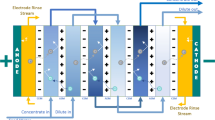Abstract
Electrodialysis (ED) and electrodialysis reversal (EDR) processes have been often used for separation of ions in dilute solutions. In this study, the performance of ED and EDR processes has been examined in the removal of copper from the dilute solutions. First, applied voltage, initial concentration, flow rate, type of electrolyte and the effect of concentration were determined for both processes. Then, separation efficiency, current efficiency, energy requirement and material flux of the processes were calculated, and the performances of the processes were compared. The separation efficiency and energy consumption of EDR process were higher compared to ED process under equal operating conditions. Also, the current efficiency (39.58%) of EDR process was lower than the current efficiency (67.46%) of ED process. It can be said that the ED process is more suitable in terms of energy consumption for separation in the low flow rate and concentration.
Similar content being viewed by others
References
D. He, M. Ma and Z. Zhao, J. Membr. Sci., 169, 53 (2000).
Ö. Arar, Ü. Yüksel, N. Kabay and M. Yüksel, Desalination, 277, 296 (2011).
H. Strathmann, Sep. Purif. Methods, 14, 41 (1985).
P. B. Spoor, L. Grabovska, L. Koene, L. J. J. Janssen and T. R. Ven, Chem. Eng. J., 89, 193 (2002).
K. S. Rao, M. Mohapatra, S. Anand and P. Venkateswarlu, Int. J. Eng. Sci. Technol., 2(7), 81 (2010).
L. J. Andres, F. A. Riera, R. Alvarez and R. Audinos, Can. J. Chem. Eng., 72, 848 (1994).
M. Alonso, A. Lopez-Delgado, A. M. Sastre and F. J. Alguacil, Chem. Eng. J., 118, 213 (2006).
H. R. Mortaheb, H. Kosuge, B. Mokhtarani, M. H. Amini and H. R. Banihashemi, J. Hazard. Mater., 165, 630 (2009).
P. K. Parhi, N. N. Das and K. Sarangi, J. Hazard. Mater., 172, 773 (2009).
J. Marchese and M. Campderros, Desalination, 164, 141 (2004).
S. K. Thampy, P. K. Narayanan, D. K. Chauhan, J. J. Trivedi, V. K. Indusekhar, T. Ramasamy, B. G. S. Prasad and J. R. Rao, Sep. Sci. Technol., 30(19), 3715 (1995).
C. Fontas, N. Pont, M. Hidalgo and V. Salvado, Desalination, 200, 114 (2006).
H. J. Lee, J. H. Song and S. H. Moon, Desalination, 314, 43 (2013).
A. Smara, R. Delimi, E. Chainet and J. Sandeaux, Sep. Purif. Technol., 57, 103 (2007).
G. Tchobanoglous, F. L. Burton, D. H. Stensel, Wastewater Engineering Treatment and Reuse, Fourth Edition, Metcalf & Eddy Inc. (Editor), McGraw-Hill Companies, Inc., New York (2003).
S. W. Jack, Separation Methods Environmental Applications, Marcel Dekker, New York (1999).
F. Valero and R. Arbós, Desalination, 253(1-3), 170 (2010).
L. Marder, G. O. Sulzbach, A. M. Bernardes and J. Ferreira, J. Braz. Chem. Soc., 14, 610 (2003).
T. J. Butter, L. M. Evison, I. C. Hancock, F. S. Holland and K. A. Matis, Water Res., 32(2), 400 (1998).
Y. Oren and Y. Egozy, Desalination, 86, 155 (1992).
R. F. Costa, D. Rodrigues and J. Z. Ferreira, Sep. Sci. Technol., 33(8), 1135 (1998).
H. G. Nowier, N. El-Said and H. F. Aly, J. Membr. Sci., 177, 41 (2000).
M. Ben Sik Ali, A. Hafiane, M. Dhahbi and B. Hamrouni, J. Memb. Separ. Technol., 3, 67 (2014).
C. V. Gherasim, J. Krivcik and P. Mikulasek, Chem. Eng. J., 256, 324 (2014).
A. Abou-Shady, C. Peng, O. J. Almeria and H. Xu, Desalination, 285, 46 (2012).
N. Kabay, H. Kahveci, Ö. İpek and M. Yüksel, Desalination, 198, 74 (2006).
K. K. Choi and T. Y. Jeoung, Korean J. Chem. Eng., 19(1), 107 (2002).
G. Lee, Desalin. Water Treat., 35, 150 (2011).
CRC Handbook of Chemistry, and Physics, 70th Ed., CRC Press, Boca Raton, FL (1989).
F. Valero, A. Barceló and R. Arbós, Electrodialysis Technology - Theory and Applications 3 Desalination, Trends and Technologies, M. Schorr Eds., InTech Inc. India (2011).
Author information
Authors and Affiliations
Corresponding author
Rights and permissions
About this article
Cite this article
Altin, S., Oztekin, E. & Altin, A. Comparison of electrodialysis and reverse electrodialysis processes in the removal of Cu(II) from dilute solutions. Korean J. Chem. Eng. 34, 2218–2224 (2017). https://doi.org/10.1007/s11814-017-0115-0
Received:
Accepted:
Published:
Issue Date:
DOI: https://doi.org/10.1007/s11814-017-0115-0




